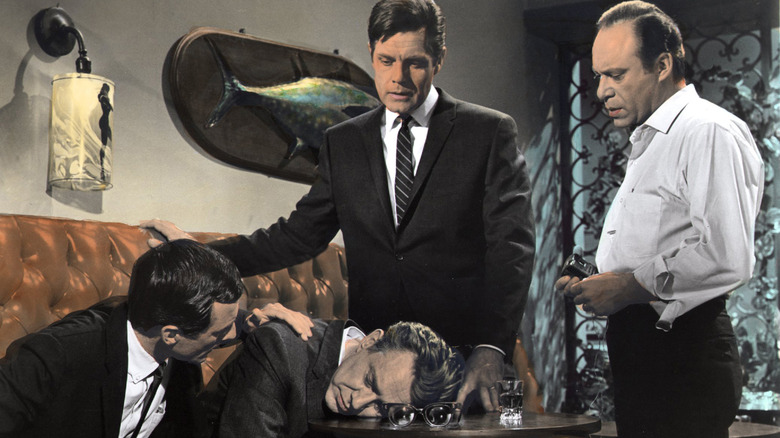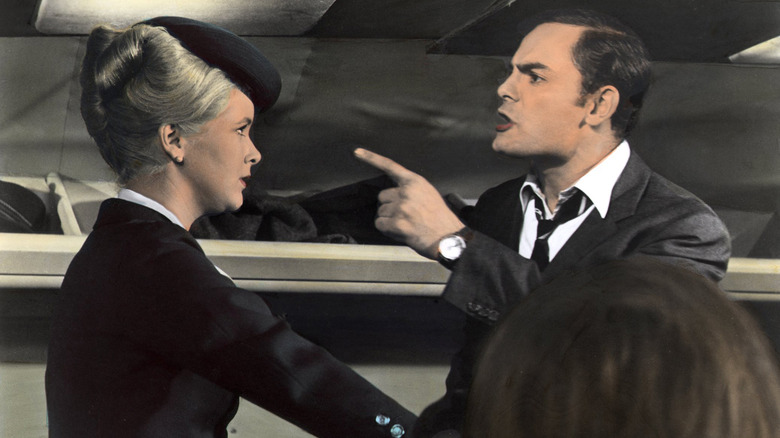How The Twilight Zone's Rod Serling Accidentally Started A Bomb Threat Epidemic
Two years after the original run of the 1960s series "The Twilight Zone" came to an end, creator Rod Serling found himself as essentially a writer for hire. In his book "The Twilight Zone Companion," author Marc Scott Zicree says Serling was "far from satisfied" at that point in his career, quoting Serling's friend, producer Dick Berg, as saying "Serling and Chayefsky were the two major names from the golden era of television. And to move from that to becoming a member of the army of working journeymen writers was a great comedown. In Hollywood, he was a guy taking assignments."
One of those assignments was a 1966 TV movie called "The Doomsday Flight." Serling wrote the screenplay, which involved a mentally disturbed mechanic who used to work for an airline planting a bomb on a commercial airliner and rigging it to explode if the plane falls below 4,000 feet. (That plot should sound somewhat familiar to viewers of Jan de Bont's action classic "Speed," which came out nearly 30 years later and involved a bomb-rigged bus which couldn't drive under 50 miles per hour without exploding.) Things turned out well in the film: The pilot manages to land in the "mile high" city of Denver, which sits at nearly 5,300 feet above sea level. Things also turned out well for NBC, the network that aired the TV movie: It pulled in the second-highest ratings of the 1966-67 season.
Unfortunately, things did not turn out well for real-life airline companies.
The Doomsday Flight led to an epidemic of bomb threats
Zicree's book says the first bomb threat arrived while the movie was still premiering. (Wow, I've begrudgingly gotta hand it to those copycat plane terrorists for moving so quickly on that one!) In the ensuing days, "TWA, Eastern, American, Pan Am and Northwest Airlines all received similar threats" — totaling eight bomb threats in six days.
"I wish to Christ I had written a stagecoach drama starring John Wayne instead," a devastated Serling told reporters in the aftermath of those threats. "I wish I'd never been born." He obviously took the news pretty hard, but I hope he eventually realized the extent to which audiences loved him and his work; it's safe to say the world of entertainment would be a different (and much worse) one if Serling had not been around to become the iconoclastic writer he did.
Unfortunately, the bomb threats didn't stop there. In the summer of 1971, almost a full five years after "The Doomsday Flight" aired for the first time, the Federal Aviation Administration asked 500 television stations across the country to stop playing the movie altogether. "You would be making the highest possible contribution to the safety of more than 160 million passengers" by not airing reruns of the film, they said, stating that their "great concern is that the film may have a highly emotional impact on some unstable individual and stimulate him to imitate the fictional situation in the movie." Since the FAA does not control what is broadcast on television, the stations could make their own decisions. Of the 500 who received the letter, only 20 responded that they would stop showing the film. But it seems the FAA won in the end: they indicated in a newspaper report at the time that they "have been led to believe that the distributor will remove ["The Doomsday Flight"] from film packages sold to stations."
The movie is currently available to watch on YouTube.
(I'd also like to issue a correction in real time regarding the copycat plane terrorists: You do not, under any circumstances, "gotta hand it to them.")

